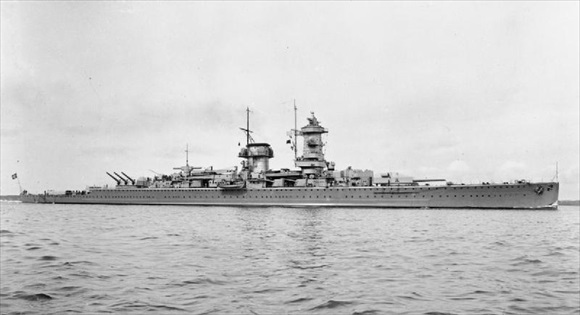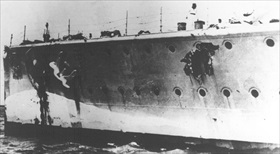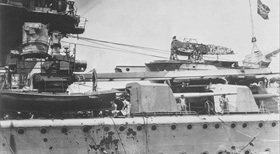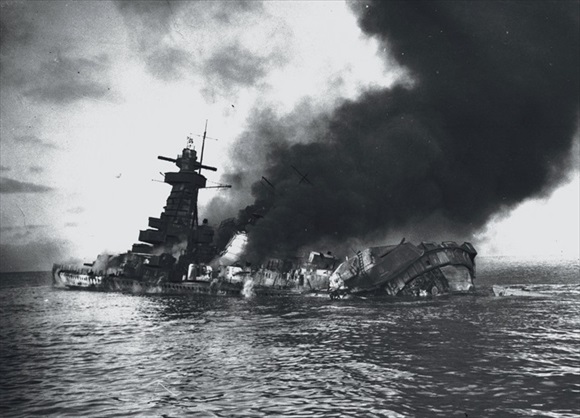BRITISH NAVY TRAPS GERMAN FLAGSHIP ADMIRAL GRAF SPEE
River Plate Estuary, Uruguay • December 13, 1939
In the first months of World War II only Great Britain’s Royal Navy, under the leadership of 65‑year-old First Lord of the Admiralty (in May 1940, Prime Minister) Winston Churchill, prosecuted the war against Nazi Germany with energy. After U‑boats had sunk the aircraft carrier HMS Courageous and the battleship Royal Oak early in the war, British warships sought out German surface commerce raiders, which Adolf Hitler had unleashed on British merchant traffic and, after December 11, 1941, on merchantmen of Britain’s allies like the United States and Canada. The most notorious of the German shipping marauders was the flagship of the Kriegsmarine, the pocket battleship (reclassified as a heavy cruiser in 1940) Admiral Graf Spee. The ship’s 2 Arado Ar 196 reconnaissance planes and its formidable triple gun turrets had managed to find and send 9 (one source said 16) British ships (over 50,000 tons) to the bottom of the Indian and South Atlantic oceans since the outbreak of war on September 3, 1939—all this allegedly without causing injury or loss of life to the crew of a single vessel. (The Graf Spee’s 45‑year‑old commander, Hans Langsdorff, ordered the captain and crew of each vessel to abandon ship before he opened fire and sank their ship.)
After scuttling her last merchantman on December 7, 1939, in the mid-South Atlantic Ocean, Langsdorff ordered his warship to make for the South American port of Montevideo at the mouth of the River Plate, the shared border between neutral Uruguay and Argentina. It was there that Admiral Graf Spee expected to meet up with a German convoy. Instead of a friendly reception, Langsdorff found 3 Royal Navy warships converging on him early on this date, December 13, 1939: the 8,390‑ton heavy cruiser HMS Exeter with 6 8‑in/203‑mm guns (in accordance with 1920s disarmament treaties) mounted in 3 deck turrets as well as 2 light cruisers, Ajax and Achilles, each armed with 6‑in/152‑mm guns. In a fierce 20‑minute clash that became known as the Battle of the River Plate, the Graf Spee’s 11.1‑in/283‑mm guns drove off the outgunned light cruisers, but in Exeter’s return fire the German battleship suffered major damage to its superstructure and, critically, its fuel system. Besides, the Graf Spee’s ammunition stocks had been depleted by two‑thirds, leaving her big guns with just 20 minutes or so of rounds to fire. Langsdorff wisely left the battlefield to retire to nearby Montevideo, not the Argentine port of Mar del Plata 200 miles/322 km south of Montevideo, which politically might have been a better choice had the immediate circumstances not been so dire. The Uruguayan authorities gave Langsdorff permission to stay no more than 72 hours to repair battle damage. The German captain’s original request for a 2‑week layover had been turned down.
During Graf Spee’s repair stop in Montevideo’s harbor the British engaged in intense diplomatic and intelligence activity (for example, spreading rumors of superior British naval forces fast approaching Uruguay), all designed to keep the German battleship bottled up while buying time to bring in heavy reinforcements. There were none in the immediate area, although Langsdorff had convinced himself that an overwhelming Allied naval force awaited his return to sea from the Uruguayan capital. Two days later, on December 17, 1939, the Graf Spee unexpectedly put to sea again, only to be dramatically scuttled in full view of 20,000 onlookers on Montevideo’s waterfront. This was the first notable British success of the war, and British media made the most of it. (See video below.) Three days later in a hotel room in the Argentine capital of Buenos Aires, Langsdorff, in full dress uniform, killed himself. His crew gave him a hero’s funeral.
Payback Time: The Last Days of Germany’s Admiral Graf Spee
 |
Above: The pocket battleship (German, panzershiff; literally, “armored ship”) Admiral Graf Spee was built to outgun and outrun any British or French warship fast enough to try to catch her—in other words, a nearly invincible ship. With a top speed of 28.5 knots/32.8 mph/52.8 km/h, only a handful of ships were capable of chasing her and powerful enough to sink her when caught. The Admiral Graf Spee’s primary armament consisted of 6 11‑in/280‑mm guns mounted in 2 triple‑gun turrets, 1 forward and another aft of the superstructure, as shown here in this 1936 photograph. Amidships was a secondary battery of 8 5.9‑in/150‑mm guns in single turrets and 2 Arado Ar 196 seaplanes. Her antiaircraft battery consisted of 6 4.1‑in/104‑mm) guns, 4 1.5‑in/38.1‑mm guns, and 10 0.79‑in/20‑mm guns. The ship also carried a pair of quadruple 21‑in/533‑mm deck-mounted torpedo tubs placed on her stern. A formidable 16,000‑ton weapon, the Graf Spee inflicted serious damage on Allied merchant shipping in the last months of 1939: 50,000 tons in British merchant shipping alone between September and December 1939.
 |  |
Left: Damaged portside bow of Admiral Graf Spee caused by an 8‑in/203‑mm shell. One of HMS Exeter’s 8‑in shells destroyed the steam boilers needed to operate the ship’s fuel-cleaning system. With no hope of replacing or repairing the system at sea, and suffering engine fatigue that reduced her top speed to 23 knots/26½ mph/42.5 km/h, Capt. Hans Langsdorff sought sanctuary and time for making emergency repairs in the Uruguayan harbor of Montevideo, arriving in the early afternoon of December 13, 1939.
![]()
Right: A close-up view of the Admiral Graf Spee’s port side, showing hull damage near the third 5.9‑in/150‑mm gun turret and the destroyed Arado Ar 196 seaplane. The 2 British light cruisers, HMS Ajax and HMS Achilles, using their 6‑in/152‑mm guns, scored 20 hits on the Admiral Graf Spee, damaging food stores and bakeries.
 |
Above: Uruguayan authorities followed international treaties and, although extending the normal 24‑hour period of safe sanctuary to 72 hours, demanded the Admiral Graf Spee leave port by 8 p.m., December 17, 1939, or else be interned for the duration of the war. The Kriegsmarine instructed Langsdorff not to let the damaged ship be interned in Uruguay (which was sympathetic to Britain in her war against Germany) or allow her to fall into enemy hands. Left to choose a strategy on his own, Langsdorff decided to scuttle the Kriegsmarine’s flagship, largely to spare his crew further casualties (36 dead and 60 wounded). (Hitler was said to be infuriated with Langsdorff’s decision.) At the limit of Uruguayan territorial waters, 10 miles/16 km from shore, the ship stopped and her crew evacuated by barge to Buenos Aires, where they were interned. Shortly thereafter, 2 of 3 planted explosives blew up the Admiral Graf Spee and she settled into the shallow estuary of the River Plate, the border between Uruguay and Argentina, burning for the next 7 days. Interestingly, the sunken warship was named after German Vice‑Adm. Maximilian Graf von Spee, who on December 8, 1914, with 800 crewmen went down with the SMS Scharnhorst, flagship of Kaiser Wilhelm’s navy, off the South Atlantic Falkland Islands, courtesy of 2 British battlecruisers. The wreck lies roughly 1,200 miles/1,931 km from Montevideo.
Newsreel Account of the End of Admiral Graf Spee Outside Montevideo, Uruguay’s Harbor (First minute of film suffers from deterioration)
![]()

 History buffs, there is good news! The Daily Chronicles of World War II is now available as an ebook for $4.99 on Amazon.com. Containing a year’s worth of dated entries from this website, the ebook brings the story of this tumultuous era to life in a compelling, authoritative, and succinct manner. Featuring inventive navigation aids, the ebook enables readers to instantly move forward or backward by month and date to different dated entries. Simple and elegant! Click
History buffs, there is good news! The Daily Chronicles of World War II is now available as an ebook for $4.99 on Amazon.com. Containing a year’s worth of dated entries from this website, the ebook brings the story of this tumultuous era to life in a compelling, authoritative, and succinct manner. Featuring inventive navigation aids, the ebook enables readers to instantly move forward or backward by month and date to different dated entries. Simple and elegant! Click 











